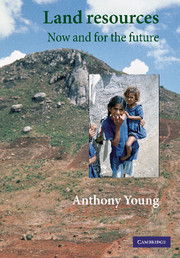Book contents
- Frontmatter
- Contents
- Preface
- Acknowledgements
- Note on acronyms and currency
- 1 Concern for land
- 2 Land resource issues
- 3 Resource survey and land evaluation
- 4 Competition for land
- 5 Working with farmers
- 6 Land use planning
- 7 Land degradation
- 8 Global issues: climatic change and biodiversity
- 9 Monitoring change: land resource indicators
- 10 Costing the earth: the economic value of land resources
- 11 Land management: caring for resources
- 12 Research and technology
- 13 Land, food, and people
- 14 Population, poverty, and conflict
- 15 Awareness, attitudes, and action
- Notes
- References
- Index
9 - Monitoring change: land resource indicators
Published online by Cambridge University Press: 04 August 2010
- Frontmatter
- Contents
- Preface
- Acknowledgements
- Note on acronyms and currency
- 1 Concern for land
- 2 Land resource issues
- 3 Resource survey and land evaluation
- 4 Competition for land
- 5 Working with farmers
- 6 Land use planning
- 7 Land degradation
- 8 Global issues: climatic change and biodiversity
- 9 Monitoring change: land resource indicators
- 10 Costing the earth: the economic value of land resources
- 11 Land management: caring for resources
- 12 Research and technology
- 13 Land, food, and people
- 14 Population, poverty, and conflict
- 15 Awareness, attitudes, and action
- Notes
- References
- Index
Summary
If policy and action to reduce land degradation are to be placed on an adequate basis, there is a clear need for land resource indicators, comparable to the economic and social indicators already in use. Only for forest clearance and biodiversity do such indicators exist. Measurable criteria, with potential to make comparisons between areas and to monitor changes over time, are needed for soil erosion, fertility decline, water resources, and the condition of rangelands. Whilst international organizations can provide guidance, assistance, and co-ordination, reliable data can only be obtained from a foundation of measurements by individual countries. The monitoring of changes to land resources should become a basic task of national resource survey organizations.
A recurrent theme of chapter 7 can be condensed into the statements:
land degradation is serious, it has already had adverse and sometimes irreversible effects on production, and it will become worse if action is not taken;
but from lack of good measurements, we do not know just how serious it is.
This dilemma is recognized in a classic understatement in Principle 15 of Agenda 21: ‘Where there are threats of serious or irreversible damage, lack of full scientific certainty shall not be used as a reason for postponing cost-effective measures to prevent environmental degradation.’
There can be no doubt, for example, that soil erosion is severe in Haiti, Lesotho, and highland Ethiopia, or that pasture degradation is widespread in the hills of northern Pakistan and many parts of the African sahel.
- Type
- Chapter
- Information
- Land ResourcesNow and for the Future, pp. 143 - 153Publisher: Cambridge University PressPrint publication year: 1998



